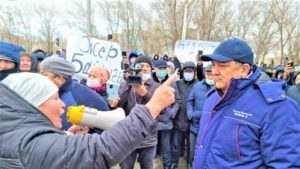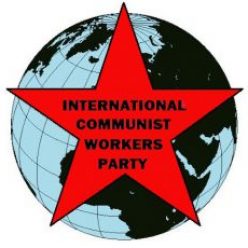Massive Protests Shake Kazakhstan

AS WE GO TO PRESS:
Mass protests in Kazakhstan started among oil workers on January 2 after the government cancelled gas and oil subsidies, putting the cost of fuel out of reach for the masses in this energy-producing country.
There are huge income inequalities in this former Soviet republic, which is ruled with an iron fist by a pro-Moscow party. Now the first protests in years have exploded into anti-government fury. Fuel subsidies were reinstated but protests continue to spread across the country despite a government crackdown.
This is a major political crisis not only for the Kazakh rulers but also for Moscow. The sharpening class contradictions in socialism (state capitalism) show the potential for communist revolution everywhere.
Workers’ Communist Revolution, or Consolidation of Capitalist-Imperialist Power?
January 9—Kazakhstan was in flames for six days, engulfed in massive violence. Demonstrations against skyrocketing energy prices spread quickly across this huge energy-rich country. The government fell.
Troops of the Russian-dominated Collective Security Treaty Organization have quelled the unrest for now. But not before many cars, private and public buildings were burned, hundreds of people killed, and thousands arrested.
These events resulted directly from the worldwide capitalist crisis. Masses rebelled against the misery imposed on them by capitalist competition for maximum profits. Industrial workers in western Kazakhstan, fresh from a recent strike wave, led the first protests.
To maximize profits, capitalists–imperialists compete ferociously for markets and for the cheapest natural resources and labor power. This inevitably leads to local, regional and world wars.
Only communist revolution can end capitalism and its unending horrors. Communism will eliminate money, wage slavery, borders, and markets. Nothing will be bought or sold, certainly not our labor power.
Wage slavery is why capitalists need racism, sexism, xenophobia, nationalism, and other poisonous divisions of the working class. Communism will enable us to get rid of them.
Kazakhstan: Product of the Failure of Socialism
The Kazakhstan crisis is an indictment of the Russian communists’ failure to fight directly for communism. They fought instead for socialism as supposedly a transition belt to communism. But socialism is state capitalism. By 1945, the Soviet Communist Party had morphed into a capitalist-imperialist class ruling a vast empire.
Contradictions within the Soviet Union sharpened, under pressure from US imperialism. Capitalist-imperialists wanting to control their own fiefdoms (nations) dissolved the Soviet Union.
Kazakhstan, among other former Soviet Republics, became “independent” in 1991. Its first president, Nursultan Nazarbayev, ruled for thirty years.
Nazarbayev astutely and skillfully balanced Kazakhstan’s relationships with the three main powers – Russia, China, and the US – while integrating it into the global economy.
He opened the gates to over $330 billion in foreign direct investment. More than half came from the European Union. The rest came from the US, Russia, China, and the UK.
This was a huge bonanza for Nazarbayev, his family and cronies, and other Kazakh capitalists. Fewer than 200 individuals now own over half the country’s considerable wealth. Meanwhile, about one Kazakh in nine lives on less than $2 a day, and the rest on about $8.25 per day.
Mass anger at this huge economic inequality fueled the rebellion’s fury.
Is Kazakhstan in a pre-revolutionary situation?
Situations like this can lead either to revolution for workers’ communist power or to some capitalists-imperialist faction further consolidating its fascist grip.
The first could only happen if there is a communist party with a mass base, capable of boldly fighting on all fronts to mobilize the masses for communism. We can learn much from the five-year period preceding the 1917 Russian Revolution.
In 1912, the Bolsheviks were decimated by seven years of fascist repression. They had only a few hundred activists in all Russia. But the Russian rulers were intensifying the exploitation of the working class in preparation for the first world war. The Bolsheviks grew exponentially by building ties in the factories and leading the fightback of increasingly radicalized workers.
When the war exploded in 1914, Bolshevik membership in St. Petersburg alone had grown to 32,000. The war further radicalized the working class, the peasantry, and fourteen million soldiers and sailors conscripted to fight it. In 1917, a quarter-million Bolsheviks led the working class to power.
US, Chinese, Russian Imperialists Exploit Kazakhstan Turmoil
When there is no such revolutionary communist party, the capitalist-imperialist competition for world domination becomes primary. Kazakhstan is no exception.
The Russian and Chinese imperialists both support Kazakh President Tokayev’s government and oppose US imperialism. But their interests also conflict.
For China, Kazakhstan is an indispensable land bridge linking its “Belt and Road Initiative” (BRI) to Europe. BRI is China’s main strategy to displace US imperialism as the dominant imperialist power.
Also, China’s energy pipelines in Turkmenistan go through Kazakhstan to its Xinjian province. China is investing $400 billion in Iran’s oil and gas industry to securely import its energy needs through these pipelines. They are crucial in case of war with the US because they bypass US-controlled sea lanes, including the strategic Strait of Malacca.
But China’s growing influence in Eurasia threatens Russia’s goal of restoring the eastern part of its former empire. Now, Russian coalition troops in control of a Kazakhstan led by pro-Russian President Tokayev further consolidate Russia’s grip.
The US, meanwhile, hopes to divert mass anger into a “color revolution” to contain both China and Russia. A pro-US regime in Kazakhstan would be an existential threat to Russia, bringing US and NATO military might to Russia’s underbelly. This, however, is unlikely. The US government and media struggled even to find on-the-ground Kazakh sources as the rebellion surged.
How do we influence worldwide events?
Certainly we must get out our analysis of these events as massively as possible. Let’s use personal contacts and social media—in Kazakh and Russian if we can. But that’s not nearly enough.
Like the Bolsheviks, we must work now to win the leadership of the working class. That means building unbreakable communist relationships with ever-widening circles of workers, soldiers, and youth, everywhere our Party exists. It means mobilizing significant groups among the masses under our direct leadership to fight for our advanced revolutionary communist concepts. Eventually, it means mobilizing millions directly in sharp class struggle against the rulers.
The Bolsheviks’ class struggle was fighting for reforms with the goal of socialism. Today we fight for directly for communism. We reject reformism, calling instead for communist class struggle.
We must respond to every capitalist attack against our class – no matter where – by organizing demonstrations, work stoppages, strikes. Not to demand reforms, but to make communist ideology a mass issue. To advance our class to better build the ICWP and fight for the communist world we need.

